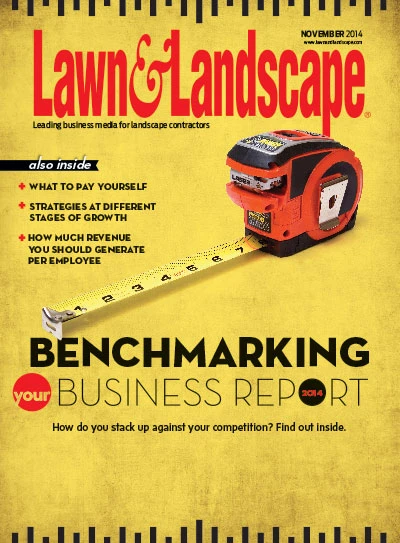
 Knowing how much revenue each employee should generate for your business helps you plan for growth – and gives you a tool to gauge productivity. With a handful of simple numbers, Jim Huston says,
Knowing how much revenue each employee should generate for your business helps you plan for growth – and gives you a tool to gauge productivity. With a handful of simple numbers, Jim Huston says,
“You can quickly measure which crews are pulling their weight, and which are not.” Employee benchmarks allow you to take the temperature of your business, see how profitable you are in the field and determine whether your labor – your greatest expense – is coming in on budget, says Huston, green industry consultant and author of “How to Price Landscape & Irrigation Projects.”
Mike Callahan, president of Callahan’s Lawn Care in Rochester, N.Y., keeps a close eye on labor costs after suffering a $70,000 loss one year when he got lax with tracking. (Read more about that on page B9.)
“We know every time we send out a mowing crew, we need to do X dollars to recover our cost, and then we build in how much more work we need to do to get our profit margin,” he says. Callahan adds, “If you can’t track it, you have no idea if you are making money.”
Rudy Larsen knows the benchmarks each employee should hit at his maintenance firm, Lawn Butler, and he implemented a pay structure to position his people to blow those targets out of the water.
He and Callahan both use a piece-rate pay system, paying employees per job rather than by hour.
Typically, a maintenance crewmember should generate $60,000 in annual revenue. At Lawn Butler in Bountiful, Utah, a maintenance laborer will make an average of $80,000 to $90,000 per year for the company.
|
Not hitting the benchmarks? You studied the benchmarks and your labor production is way off. Why? Here are some areas to consider. Route scheduling: How tight are your routes? Are you using a GPS system to optimize drive time? Windshield time is a revenue drain for crews. It’s time when they are not producing income for your business. Take a close look at routing and determine if your trucks are clocking too many miles or idling for too long at rest stops (the gas station, a fast-food joint) along the way. Labor performance: If one crew is producing less revenue than it should, consider who’s leading that team. Perhaps the crew leader is not pulling his or her weight in the field. This could be the case if other crews are hitting benchmarks. Equipment in service: How effective is your equipment? Are your mowers cut out for the jobs you sell? The walk-behinds you started your residential lawn mowing business with will rob your revenue potential if you use the same equipment on larger properties. How old is your equipment? Consider whether now is time to upgrade your equipment so your employees can produce more revenue for your business. |
Callahan shoots for $70,000 to $80,000 of production per maintenance person, per year – a two-man crew produces between $150,000 and $200,000 annually.
But as Huston outlines in the following employee benchmarks, $60,000 per year for a maintenance laborer is your starting point.
If you beat this, you’re in even better shape. These numbers help landscapers answer the questions: Where do I stand? How can I grow?
For example, knowing an installation crewmember should bring in $100,000 in revenue per year, a company that wants to jump from $500,000 to $700,000 would need to add a two-man installation crew, and of course build a backlog of sales to keep that crew busy.

Get curated news on YOUR industry.
Enter your email to receive our newsletters.
Explore the November 2014 Issue
Check out more from this issue and find your next story to read.
Latest from Lawn & Landscape
- Project EverGreen helps revitalize Milan Park in Detroit
- Trex Company wins Product of the Year, Judges’ Choice Winner at Environment+Energy Leader Awards
- General Equipment & Supplies in Fargo adds Takeuchi equipment
- Mariani Premier Group acquires Hazeltine Nurseries
- EnP Investments adds Mark McCarel as Northeast territory sales manager
- Our April issue is now live
- Ready or not
- Tribute to an industry guru






